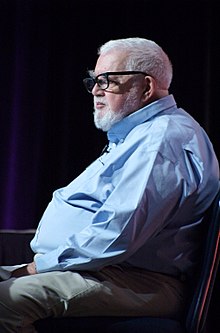John McCarthy (computer scientist)
[2] He received many accolades and honors, such as the 1971 Turing Award for his contributions to the topic of AI,[3] the United States National Medal of Science, and the Kyoto Prize.
The family was obliged to relocate frequently during the Great Depression, until McCarthy's father found work as an organizer for the Amalgamated Clothing Workers in Los Angeles, California.
He showed an early aptitude for mathematics; during his teens, he taught himself college math by studying the textbooks used at the nearby California Institute of Technology (Caltech).
McCarthy completed his graduate studies at Caltech before moving to Princeton University, where he received a PhD in mathematics in 1951 with his dissertation "Projection operators and partial differential equations", under the supervision of Donald C.
By the end of his years at Massachusetts Institute of Technology (MIT) he was already affectionately referred to as "Uncle John" by his students.
McCarthy championed mathematics such as lambda calculus and invented logics for achieving common sense in artificial intelligence.
John McCarthy is one of the "founding fathers" of artificial intelligence, together with Alan Turing, Marvin Minsky, Allen Newell, and Herbert A. Simon.
McCarthy, Minsky, Nathaniel Rochester and Claude E. Shannon coined the term "artificial intelligence" in a proposal that they wrote for the famous Dartmouth conference in Summer 1956.
In the late 1950s, McCarthy discovered that primitive recursive functions could be extended to compute with symbolic expressions, producing the Lisp programming language.
[19] Around 1959, he invented so-called "garbage collection" methods, a kind of automatic memory management, to solve problems in Lisp.
His colleague Lester Earnest told the Los Angeles Times: The Internet would not have happened nearly as soon as it did except for the fact that John initiated the development of time-sharing systems.
His second wife was Vera Watson, a programmer and mountaineer who died in 1978 attempting to scale Annapurna I Central as part of an all-women expedition.
He later married Carolyn Talcott, a computer scientist at Stanford and later Scientific Research Institute (SRI) International.
In 1980 the philosopher John Searle responded with his famous Chinese Room Argument,[39][15] disagreeing with McCarthy and taking the stance that machines cannot have beliefs simply because they are not conscious.
